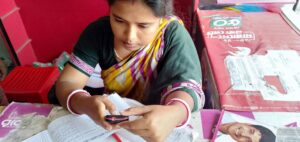With a growing gender gap in financial inclusion in Bangladesh, it is imperative to understand the behavioral barriers women face when engaging with digital financial services. Passive account openings, limited use cases, the role of cash and lack of differentiation are contributors to low usage, preventing women from being financially included and financial service providers from untapping the tremendous market opportunity women have in Bangladesh.
According to the Global Findex, the percentage of mobile money accounts has jumped from three percent in 2014 to 21 percent in in 2017 in Bangladesh. At the same time, the gender gap in account ownership has widened—from nine percent in 2014, to 29 percent in 2017, representing a disturbing trend affecting the progress of women’s financial inclusion in Bangladesh. Furthermore, a vast majority of women who do have accounts are using them less frequently than men.
Women’s World Banking knows that women in Bangladesh can be promising digital financial services (DFS) customers, but the question is: Exactly how will digital financial services work for women in Bangladesh?
The obvious answer is to design solutions based on deep understanding of women clients in Bangladesh. Establishing the right partnerships, conducting qualitative and quantitative research on the ground to better understand the financial needs and barriers that women face are critical to opening up the market opportunity to serve the 41.3 million un- and under-banked Bangladeshi women.

As one of the largest mobile money providers in Bangladesh, Dutch Bangla Bank (DBBL) has enormous potential to drive financial inclusion for women through its mobile money account offering, Rocket. Rocket provides financial services by offering cash-in, cash out, merchant payment, utility payment, salary disbursement, foreign remittance, government allowance disbursement, and ATM withdrawal via mobile devices.
Women’s World Banking has partnered with MetLife and DBBL to better understand the financial behaviors and experiences of DBBL Rocket’s women customers. These findings will inform the design process and ensure that any solutions created to meet the needs of women Rocket customers and further their financial engagement.
Data helps us better understand low usage of DBBL Rocket by women customers
Initial data analysis concluded that although DBBL Rocket has a large customer base, its customers are predominately inactive, with only a 23 percent activity rate as compared to the industry benchmark of 30 percent. It also revealed that DBBL Rocket’s transaction types—cash-in/out, disbursement, P2P, airtime top-up, bill payment, and merchant payment—were all below the industry benchmark.
Women’s World Banking conducted qualitative behavioral customer research to better understand DBBL Rocket’s customers’ behavior and interactions with their mobile money account.
Using Women’s World Banking’s proprietary Women-Centered Design research methodology four key behavioral barriers emerged from Rocket’s women customers when deciding how to use their account:
- Rocket is not an active choice
Across all customer segments, customers did not choose to open their accounts. Instead, accounts were opened for them: employers open the accounts for women who use the account for salary disbursement; schools open accounts for women who receive government stipends; and for other accounts that fall into a “general” category, family and friends often open the account for women in order to facilitate a transaction. This passive relationship with the product makes customers less likely to use it. - Usage is driven predominately by cash-out
The customer’s main use of the account is driven by cashing-out. Women do not see the account for any other purposes than receiving and getting their money. - Cash is still king
The way which customers are carrying out their financial transactions is still driven by cash. - Lack of differentiation
If customers use Rocket, they are using it interchangeably alongside its competitor. They don’t see the difference between products.
Women-centered design will deepen engagement in order to drive transactions
Women have the potential to become complex, multi-case users of DBBL Rocket, given the right opportunities and resources.
In order to drive account usage, the team’s work will focus on decreasing the cash-out rate, while simultaneously increasing and creating opportunities for women to use their accounts. By making these opportunities salient to women customers, Rocket can begin to introduce and create new use cases, such as savings.
Women’s World Banking will use an iterative Women-Centered Design process with co-creation techniques to take these insights and transform them into commercially viable and customer-centric designs that work for the women customers and for DBBL. This approach forms a central part of Women’s World Banking’s strategy to address the deepening gender gap in Bangladesh.
Women’s World Banking’s work with DBBL is generously supported by the MetLife Foundation.



